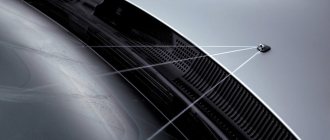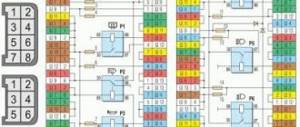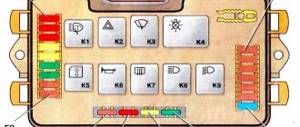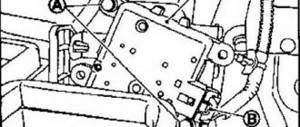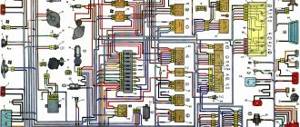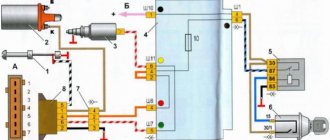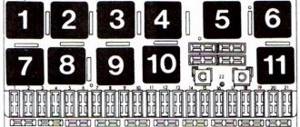The windshield washer pump provides sufficient pressure in the system to supply water to the glass. This is one of the most important components in a car, which is always necessary, and not just in bad weather. Let's figure it out with you where the windshield washer motor is installed, what its features are and how to replace and clean it.
The principle of operation of the motor
This motor is used to create the necessary pressure and supply water. Its design differs depending on the brand. This is due to the fact that sometimes water supply is required not only to the windshield, but also to the rear view glass. In general, the principle of operation is no different from that characteristic of any other water pump, it’s just that this one has small dimensions and works not only with water, but also with washer fluid, that is, in an aggressive environment. The windshield washer motor can fail, like any other component in the car, but unlike the same engine, every driver can easily repair it on his own.
How the washer works
The windshield washer device is quite simple - nozzles, a pump and a water tank. When activated, the pump takes part of the liquid from the tank and transfers it to the nozzles. From them, water flows to the middle of the windshield, from where the wipers take it.
The most active part of the device is the pump. It accounts for the lion's share of all malfunctions. The main part is the transport motor, which consists of brushes, seals and an impeller.
Windshield washer pump
Mechanism malfunctions are divided into mechanical and electrical. Mechanical causes are traditionally caused by the drivers themselves. Electrical ones are caused by a failure of the current transmission circuit to the moving parts of the mechanism. Most problems can be identified and fixed on your own.
Typical causes of unit failure
Over a long period of car servicing, most car service specialists identify the following “standard” motor breakdowns:
- damage to terminals;
- disconnecting the hose;
- clogged injectors;
- Washer switch malfunction.
These are the problems that occur most often. The most common and simple one is that the hose under the hood has come off. The liquid enters and simply pours into the engine compartment. In general, the problem is not critical; just adjust the hose and everything will work immediately.
As many years of practice have shown, the mechanism itself is simple and extremely reliable, so it very rarely fails. Another thing is that the contacts oxidize and may not give the desired signal. Or everything is so clogged with rust and dirt that the pump is unable to push through this plug. Situations are different, in any case, if the windshield washer motor does not work, you need to figure it out and see what’s wrong. Sometimes the reasons lie on the surface.
Details of the whole
As you can see, the window washing system is not that complicated. It consists of several simple components: a motor, a tank and injectors. Of course, there are also lines through which the washer fluid passes. The pump pumps liquid, which, under pressure, approaches the tee. Tee - washer fluid distributor. Then it is sprayed through the nozzles directly onto the center of the windshield and spread around the perimeter by the wipers.
Nothing complicated, but at the same time there are a lot of details. In the event of a malfunction, immediately check the tank and its integrity, as well as the nozzle; it may be clogged with dirt that needs to be removed. Next, check the pump - if it buzzes, then everything is in order. If not, disconnect and completely clean, also clean the terminals. Highways are also a fairly important element. They may bend or break somewhere, and the liquid will not pass through. And, of course, the injectors play their role. To save washer fluid, they spray it very sparingly. From this we can conclude that the spray holes are small in diameter. Therefore, there are often cases when they become clogged and the system stops working.
Replacing the windshield washer pump. VOLVO S70, 850, V70I, C70I
The recipe for replacing the washer pump on a Volvo is quite simple. The symptoms, in general, are also understandable: if the pressure of the washer fluid on the windshield in your Volvo has decreased or disappeared altogether, then most likely the pump that is in the windshield washer reservoir has died.
Prices for this pump vary from 200 rubles for a Chinese GP engine to 1500 for an original Volvo. In my case, I took a German average for 500 rubles. But, at ambient temperatures below 8-10 degrees, the pressure of this motor decreases very much. This disappointed me. This did not happen with the original motor. It is likely that the problem is in the lubricant, which is not designed for such temperatures and thickens in severe frost, preventing the normal operation of the engine. Alternatively, you can find an original control unit at a Volvo disassembly site - most likely it will work better than its analogue. At least there is such hope. In any case, replacing this element is not difficult, and its price is quite reasonable.
So, let's start replacing.
First, park your Volvo on a level and clean place and turn the steering wheel to the left until it stops. Next, we’ll take out a jack and lift the car from the right side - it will be easier for us to crawl under the bumper there.
Next, unscrew the screws that connect the right front wheel arch liner to the front bumper. There seem to be 3 of them. Now we lay something under this angle, lie down on the ground and look under the bumper. There we have a view of the windshield washer fluid reservoir. And on the side of the bumper, there is a motor stuck into it, which pumps this liquid onto our glass. 1 rubber hose for the washer comes off from it, and on top (we can’t see it yet) there’s a power plug stuck into it.
Most likely, when you come to replace this pump, your Volvo's washer reservoir is full of fluid. Therefore, we take a 5-liter bottle, bucket or basin and place it under the motor and tank, and by hand we crawl up and disconnect the rubber line. The liquid will drain slowly as it passes through the motor. If the washer reservoir was full, then it will take at least 20-25 minutes to drain everything. So you can relax and wait.
After everything is glass, you need to manage to pull the motor out of the washer reservoir. It is stuck there with its nose through a rubber gasket. It sits there tightly, and you can help yourself with a flat-head screwdriver. After it comes out, some more liquid will pour out of the tank, be prepared for this.
Next, you need to disconnect the chip from the pump and plug it into the new one. The chip wire is short. Therefore, you need to bend the bumper from the side of the wheel, where we unscrewed it from the fender liner. Bend it and manage to stick your hand into this gap, this will give you a much better chance of disconnecting the chip from the motor without damaging it. Similarly, we connect the chip to the new motor and push it into the washer fluid reservoir.
Next, we connect the rubber line back to the pump, lower the car, screw the fender liner back to the bumper and enjoy the working windshield washer (and headlights, actually).
In general, the operation is not complicated and can be carried out by anyone; moreover, it does not require special skills or tools other than a screwdriver and a jack. Good luck to you and your Volvo.
How to replace a windshield washer motor
As noted above, the design of the motor may differ depending on the brand of car. This also applies to its location. However, if you can find the windshield washer reservoir, there shouldn't be any problems. What you will need from the tool is a regular flathead and Phillips screwdriver, as well as a set of keys.
As for the components, their price tag is low. Purchases will cost 500-1,500 rubles, depending on what you purchase. Then we proceed directly to the replacement. We find the tank and motor. We disconnect the terminals; it is advisable to check them immediately. If there is a large amount of rust, then it must be carefully removed and try to check the performance of the system.
We continue repair work
Once you have determined where the windshield washer motor is located and disconnected it, you need to follow these steps. Drain the liquid, if there is any in the system. To do this, disconnect the hose and fitting. Next you need to push the intake out of the sealing sleeve. The easiest way to do this is with a regular flat-head screwdriver. At the same time, we try not to damage anything, since the products are quite fragile. Now we can disconnect the pump from the tank and start cleaning it. You can clean it in any convenient way, preferably with a regular eraser - it’s simple and fairly quick.
How much does a windshield washer motor cost if it breaks? If for a domestic car, then a couple of hundred rubles, if for a foreign car, it’s more expensive. Usually 1,000 or more. But it needs to be changed only if there is obvious mechanical damage or critical wear.
How to remove and install the washer pump on a VAZ 2110-2112
This design is quite easy to remove. First of all, disconnect the power wires, as clearly shown in the photo below.
After this, disconnect the hose by pulling it with medium force. Of course, there should be no water in the tank.
Now you can use a flat-head screwdriver to pry the motor and pull it out of its seat. It will take a moderate amount of force for the pump to pop out of the rubber seal.
As a result, we get the following result:
We install the new one in the reverse order. The price of this part is about 200 rubles, if you take the original version. As for the motors for rear window washers in cars such as VAZ 2111 and 2112, this procedure will be similar.
Inspecting the rubber seals
Most often, seals and gaskets are the cause of system failure. This is due to the fact that over time the rubber hardens, cracks, and so on. Accordingly, the gasket does not perform its functions. If during repairs you discover a faulty bushing, replace it. This will significantly extend the life of your pump. The same applies to other seals. We try to throw away everything that looks bad or is cracked and puts in a new one.
We are approaching the final part
Almost always, the windshield washer motor is non-removable. That is, you will not be able to inspect its internal parts, such as the stator and armature. The body is poured at the factory, only replacement of the failed part is provided. But you and I are not looking for simple ways and we can sort out the incomprehensible. For this we need a hacksaw. With its help, we make a neat cut along the pump step and, using a flat-head screwdriver, divide it into two halves.
Carefully remove the armature with brushes from the motor stator. It is important not to bend or break anything. Next we get to cleaning. We rub everything until it shines and try to completely get rid of corrosion. We replace the oil seal, which was causing the fluid to leak, and put everything back together. To do this, use a soldering iron or glue. We check the functionality. Everything should function without the slightest sign of wear.
Windshield washer does not work due to electrical reasons
The windshield washer pump is powered by electricity. If it is not supplied, it will not pump water and transfer it to the nozzles. The following causes of electrical washer malfunction can be identified:
- Faulty fuse. To make sure of this, you need to find the fuse box and determine which one is responsible for the operation of the washer. A failed fuse can be diagnosed visually or experimentally. If you are not sure that the fuse is not working, install one of the identical unit fuses in its place, and then make sure that the washer is working or not by drawing conclusions about the condition of the fuse.
- The problem is in the command transmission chain from the steering to the washer. If the washer switch is broken or the command from it does not reach the mechanism, you should check the circuit for breaks. Before you begin, make sure there is no voltage at the washer pump terminals. To do this, turn on the device and check the voltage with a multimeter. If it is missing, you will have to look for the break in the wiring.
- Faulty pump. During operation, the pump terminals, if water gets on them, can oxidize and become faulty, causing the washer to stop working. If there are traces of rust on the terminals or contacts, clean them.
The reasons why the windshield washer does not work are most often obvious. The mechanism contains a minimum of components, and the most unpleasant malfunction can be considered an electrical circuit break, the search for which may require the services of specialists, while the driver can fix all other problems on his own.
( 458 votes, average: 4.55 out of 5)
Fuel filter: symptoms of contamination, how and when to change
How to rinse and clean a car radiator yourself
